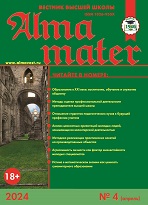UDC 316.36-053
https://doi.org/10.20339/AM.02-21.114
M.M. Kanarskij is junior scientist researcher at Federal Scientific Clinical Center of Reanimatology & Reabilitation e-mail: Kanarmm@yandex.ru ORCID: 0000-0002-7635-1048; Yu.Yu. Nekrasova is scientist researcher at Moscow Aviation Institute and Federal Scientific Clinical Center of Reanimatology & Reabilitation e-mail: nekrasova84@yandex.ru; I.V. Borisov is junior scientist researcher at Federal Scientific Clinical Center of Reanimatology & Reabilitation e-mail: realzel@gmail.com; and V.A. Bondar’ is PhD student ORCID: 0000-0002-3244-463Х
at National Medical Research Center for Children Health
Examined is the problem of lowering of birth rate, provoking serious anxiety in number of developed countries of Europe, North America and Asia. In Russia solution of this problem declared national priority, and for its solution are spending solid economic resources. One of reasons of lowering birth rate in Russia is in changing of attitude of the youth to the institute of marriage and family as well as egocentric vector of interests of personality. In our research, we evaluate attitude to marriage of medical students in Russian university, and also their life principles and orientations as to formation of a family.
Key words: demography, marriage, family, students, survey.
References
1. Galanti, G.A. The Hispanic family and male-female relationships: an overview. Journal of transcultural nursing: official journal of the transcultural nursing society. 2003. No. 14 (3). P. 180–185. URL: https://doi.org/10.1177/1043659603014003004
2. Bosley-Smith, E.R., & Reczek, C. Before and After “I Do”: Marriage Processes for Mid-Life Gay and Lesbian Married Couples. Journal of homosexuality. 2018. No. 65 (14). P. 1985–2004. URL: https://doi.org/10.1080/00918369.2017.1423213
3. Martin, J.A., Hamilton, B.E., Osterman, M.J., Curtin, S.C., & Matthews, T.J. Births: final data for 2013. In: National vital statistics reports: from the Centers for Disease Control and Prevention, National Center for Health Statistics, National Vital Statistics System. 2015. No. 64 (1). P. 1–65.
4. Agisheva, G.N. Problems of student family. In: Materials of the 4th Periodic All-Russia congress “Sociology and society: global challenges and regional development”. 2012. P. 3292–3294.
5. Marinova, M.A. Principal sociological and economic approachesa to study in household management. Vestnik RUDN. Serie: Sociology. 2004. No. 6–7. P. 202–211.
6. Song, O., Neuberg, S.L., Varnum, M., & Kenrick, D.T. The crowded life is a slow life: Population density and life history strategy. Journal of Personality and Social Psychology. 2017. No. 112(5). P. 736–754. URL: https://doi.org/10.1037/pspi0000086
7. URL: http://gks.ru
8. Khazeeva, A.I., Valeeva, L.R. Attitude of medical students to family and marriage on modern stage. Scientific Aspect. 2013. No. 1. P. 228.











.png)






